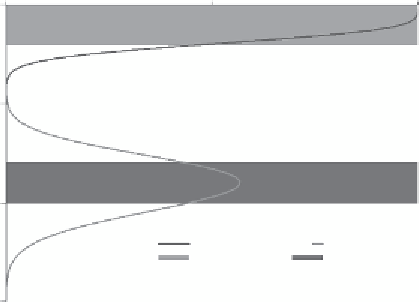Geoscience Reference
In-Depth Information
Concentration in liquid phase in soil (mg L
-1
)
0
0.5
1
0
−50
−100
t
=10 d CON+DIS
t
= 50 d CON+DIS
t
= 50 d CON
t
=10 d CON
No adsorption
−150
Figure 5.3
Solute concentration proiles after 10 and 50 days in case of convection
only and in case of convection plus dispersion respectively (experimental data
Fig-
ure 5.2
).
move faster and other solutes stay behind compared to the average solute velocity
equal to
q
/
θ =
-2 cm d
-1
. Whereas near the soil surface the concentrations are close
to 1 mg L
-1
, deeper in the soil dispersion causes a gradual decline of the concentra-
tions. Note that the surface areas of the solute proiles are equal at all times, whether
dispersion is included or omitted.
Question 5.4:
Why are the surfaces below the solute proiles equal for each case?
5.3 Convection-Dispersion Equation
By considering conservation of mass in an elementary cubic volume (
Figure 5.4
), we
may derive the mass balance or continuity equation for solute transport:
∂
∂
=−
∂
C
t
J
z
T
∂
−
S
s
(5.6)
where
C
T
is the total solute concentration in the soil system (kg m
-3
) and
S
s
is the
solute sink term (kg m
-3
d
-1
) accounting for decomposition and uptake by roots.
The solutes may be dissolved in soil water or may be adsorbed to organic matter
or clay minerals:
CCC
T
=
ρ θ
(5.7)
b
a
l
where
ρ
b
is the dry soil bulk density (kg m
-3
) and
C
a
is the solute amount adsorbed
(kg kg
-1
). By combining Eqs. (
5.5
)-(
5.7
) and deining the effective diffusion


Search WWH ::

Custom Search